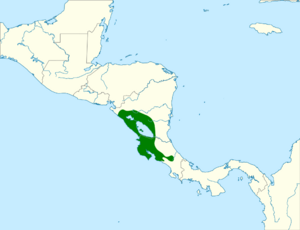Blue-vented hummingbird facts for kids
Quick facts for kids Blue-vented hummingbird |
|
|---|---|
 |
|
| Conservation status | |
| Scientific classification | |
| Genus: |
Saucerottia
|
| Species: |
hoffmanni
|
 |
|
| Synonyms | |
|
Amazilia saucerottei hoffmanni |
|
The blue-vented hummingbird (Saucerottia hoffmanni) is a tiny, colorful bird. It is a type of hummingbird known for its bright feathers. You can find this special bird living in Costa Rica and Nicaragua in Central America.
Contents
What's in a Name? (Taxonomy)
Scientists group living things into categories to understand them better. The blue-vented hummingbird used to be considered a type of steely-vented hummingbird. It was thought to be a subspecies, which is like a close relative.
However, after studying their DNA, scientists decided it was different enough to be its own unique species. So, they moved it to a new group, or genus, called Saucerottia. This means it now has its own special name, Saucerottia hoffmanni.
Meet the Blue-Vented Hummingbird
This hummingbird is quite small, usually about 8 to 11 centimeters (3 to 4 inches) long. It weighs about 4.45 grams, which is less than a nickel!
- Bill: Both male and female hummingbirds have a straight bill. The top part is black, and the bottom part is a pretty coral-red with a dark tip.
- Males: Adult males are very shiny. Their upper body is a golden-green color. Their lower back and tail feathers can look coppery or purplish. Their belly and chest are a sparkling golden-green, and the feathers under their tail are greenish to steel blue. Their tail is slightly forked and a pale steel blue.
- Females: Adult females look similar but are a bit less bright. Their lower chest and belly are a duller green. They have small white bars on their throat feathers. The feathers near their vent (bottom) have grayish-buff edges. The tips of their outer tail feathers are purplish.
- Young Birds: Young hummingbirds are darker than adults. Their green colors are not as bright, and their belly is grayish-brown. Their throat is dark gray, and some feathers on their back have brownish edges.
Where Do They Live? (Distribution and Habitat)
The blue-vented hummingbird lives in a specific area. You can find them from the southern parts of Nicaragua down to central Costa Rica.
They like to live in places that are partly open. This includes:
- Areas with lots of scrubland (bushes and small trees).
- Open grasslands called savanna.
- The edges of thick, old forests.
- Newer forests that have grown back after old ones were cut down (called secondary forest).
- Even in gardens!
They usually prefer drier areas. But during the dry season, they might move to places that are a bit wetter. You can find them from sea level all the way up to about 1,800 meters (5,900 feet) high in the mountains.
How They Live (Behavior)
Moving Around
Blue-vented hummingbirds don't stay in one spot all the time. They move around locally. This means they travel short distances to find places where flowers are blooming. They follow the flowers to get their food!
What Do They Eat? (Feeding)
Hummingbirds are famous for eating nectar, which is a sweet liquid from flowers. The blue-vented hummingbird gets nectar from many different kinds of plants, vines, shrubs, and trees. They usually feed on plants that are not taller than small trees. They often protect their favorite feeding spots from other birds.
Besides nectar, they also eat tiny insects. They catch these insects while flying, or sometimes they pick them off the surface of water.
Starting a Family (Breeding)
We don't know a lot about how blue-vented hummingbirds raise their young. But it seems their breeding season lasts from at least December to April.
They build a small, cup-shaped nest. They make it from soft plant fibers and spiderwebs. They often decorate the outside of the nest with lichen. One nest was found on a dead branch of a Cecropia tree, and another was on a Ficus vine.
What Do They Sound Like? (Vocalization)
The blue-vented hummingbird has a special song. It sounds like a buzzing, squeaky phrase: tzi-tzee-tzup. Sometimes, they add a few lower notes after it, like tzi-tzee-tzup ... wut-chur-up.
They also make short calls. These calls are described as a high, sharp tsit or a dry chit. Sometimes, they make a quick series of these sounds.
Their Place in the World (Status)
The group that checks on the health of animal populations, called the IUCN, hasn't looked at the blue-vented hummingbird separately yet. This is because some organizations still consider it part of the steely-vented hummingbird species. So, its conservation status is currently grouped with that bird.

